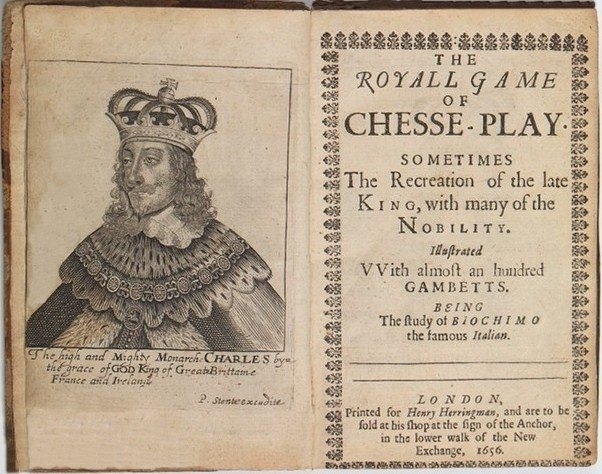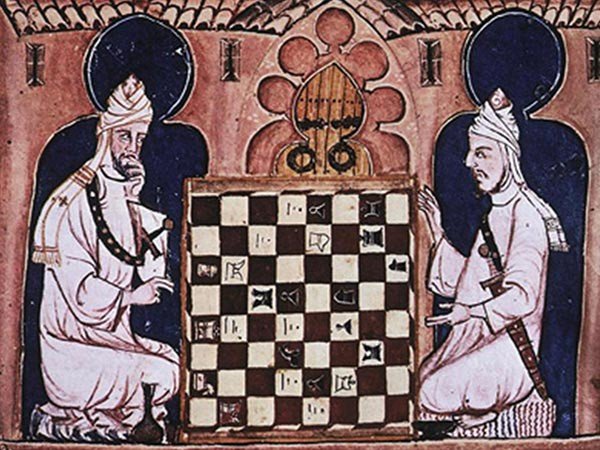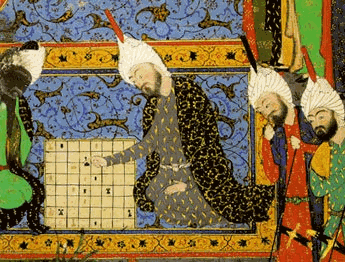History of Chess

The precursors of chess originated in India during the Gupta Empire, where its early form in the 6th century was known as chaturaṅga, which translates as "four divisions (of the military)": infantry, cavalry, elephantry, and chariotry, represented by the pieces that would evolve into the modern pawn, knight, bishop, and rook, respectively.
Chess was introduced to Persia from India and became a part of the princely or courtly education of Persian nobility. In Sassanid Persia around 600 the name became chatrang, which subsequently evolved to shatranj, and the rules were developed further. Players started calling "Shāh!" (Persian for "King!") when attacking the opponent's king, and "Shāh Māt!" (Persian for "the king is helpless") when the king was attacked and could not escape from attack. These exclamations persisted in chess as it traveled to other lands.
The game was taken up by the Muslim world after the Islamic conquest of Persia, with the pieces largely keeping their Persian names. The Moors of North Africa rendered Persian "shatranj" as shaṭerej, which gave rise to the Spanish acedrex, axedrez and ajedrez; in Portuguese it became xadrez, and in Greek zatrikion, but in the rest of Europe it was replaced by versions of the Persian shāh ("king"). Thus, the game came to be called ludus scacchorum or scacc(h)i in Latin, scacchi in Italian, escacs in Catalan, échecs in French (Old French eschecs); schaken in Dutch, Schach in German, szachy in Polish, šahs in Latvian, skak inDanish, sjakk in Norwegian, schack in Swedish, šakki in Finnish, šah in South Slavic languages, sakk in Hungarian and şah in Romanian; there are two theories about why this change happened:
From the exclamation "check" or "checkmate" as it was pronounced in various languages.
From the first chessmen known of in Western Europe (except Iberia and Greece) being ornamental chess kings brought in as curios by Muslim traders.
The Mongols call the game shatar, and in Ethiopia it is called senterej, both evidently derived from shatranj.
Chess spread directly from the Middle East to Russia, where chess became known as шахматы (shakhmaty, treated as a plural).
The game reached Western Europe and Russia by at least three routes, the earliest being in the 9th century. By the year 1000 it had spread throughout Europe. Introduced into the Iberian Peninsula by the Moors in the 10th century, it was described in a famous 13th century manuscript covering shatranj, backgammonand dice named the Libro de los juegos.
Chess spread throughout the world and many variants of the game soon began taking shape. Buddhist pilgrims, Silk Road traders and others carried it to the Far East where it was transformed and assimilated into a game often played on the intersection of the lines of the board rather than within the squares.Chaturanga reached Europe through Persia, the Byzantine empire and the expanding Arabian empire. Muslims carried chess to North Africa, Sicily, and Iberia by the 10th century.
The game was developed extensively in Europe, and by the late 15th century, it had survived a series of prohibitions and Christian Church sanctions to almost take the shape of the modern game. Modern history saw reliable reference works, competitive chess tournaments and exciting new variants which added to the game's popularity, further bolstered by reliable timing mechanisms (first introduced in 1861), effective rules and charismatic players.
India

The earliest precursor of modern chess is a game called chaturanga, which flourished in India by the 6th century, and is the earliest known game to have two essential features found in all later chess variations — different pieces having different powers (which was not the case with checkers and go), and victory depending on the fate of one piece, the king of modern chess.[9] Other game pieces (speculatively called "chess pieces") uncovered in archaeological findings are considered as coming from other, distantly related, board games, which may have had boards of 100 squares or more. Findings in the Mohenjo-daro and Harappa (2600–1500 BCE) sites of the Indus Valley Civilization show the prevalence of a board game that resembles chess.
Chess was designed for an ashtāpada (Sanskrit for "having eight feet", i.e. an 8x8 squared board), which may have been used earlier for a backgammon-type race game (perhaps related to a dice-driven race game still played in south India where the track starts at the middle of a side and spirals in to the center).Ashtāpada, the uncheckered 8×8 board served as the main board for playing Chaturanga. Other Indian boards included the 10×10 Dasapada and the 9×9 Saturankam. Traditional Indian chessboards often have X markings on some or all of squares a1 a4 a5 a8 d1 d4 d5 d8 e1 e4 e5 e8 h1 h4 h5 h8: these may have been "safe squares" where capturing was not allowed in a dice-driven backgammon-type race game played on the ashtāpada before chess was invented.
The Cox-Forbes theory, started in the late 19th century, mainly from the works of Captain Hiram Cox and Duncan Forbes, proposed that the four-handed game chaturaji was the original form of chaturanga. Other scholars dispute this and say that the two-handed form was the first.
In Sanskrit, "chaturanga" (चतुरङ्ग) literally means "having four limbs (or parts)" and in epic poetry often means "army" (the four parts are elephants, chariots, horsemen, foot soldiers). The name came from a battle formation mentioned in the Indian epic Mahabharata. The game Chaturanga was a battle simulation game which rendered Indian military strategy of the time.
Some people formerly played chess using a die to decide which piece to move. There was an unproven theory that chess started as this dice-chess and that the gambling and dice aspects of the game were removed because of Hindu religious objections.
Scholars in areas to which the game subsequently spread, for example the Arab Abu al-Hasan 'Alī al-Mas'ūdī, detailed the Indian use of chess as a tool for military strategy, mathematics, gambling and even its vague association with astronomy. Mas'ūdī notes that ivory in India was chiefly used for the production of chess and backgammon pieces, and asserts that the game was introduced to Persia from India, along with the book Kelileh va Demneh, during the reign of emperor Nushirwan.
In some variants, a win was by checkmate, or by stalemate, or by "bare king" (taking all of an opponent's pieces except the king).
In some parts of India the pieces in the places of the Rook, Knight and Bishop were renamed by words meaning (in this order) Boat, Horse, and Elephant, or Elephant, Horse, and Camel, but keeping the same moves.
In early chess the moves of the pieces were:
King: as now.
Queen: one square diagonally, only.
Bishop: In the version that went into Persia: two squares diagonally (no more or less), but could jump over a piece between In a version sometimes found in India in former times: two squares sideways or front-and-back (no more or less), but could jump over a piece between. In versions found in Southeast Asia: one square diagonally, or one square forwards.
Knight: as now.
Rook: as now.
Pawn: one square forwards (not two), capturing one square diagonally forward; promoted to queen only.
Two Arab travelers each recorded a severe Indian chess rule against stalemate[24]:
A stalemated player thereby at once wins.
A stalemated king can take one of the enemy pieces that would check the king if the king moves.
Iran (Persia)

The Karnamak-i Ardeshir-i Papakan, a Pahlavi epical treatise about the founder of the Sassanid Persian Empire, mentions the game of chatrang as one of the accomplishments of the legendary hero, Ardashir I, founder of the Empire. The oldest recorded game in chess history is a 10th century game played between a historian from Baghdad and a pupil.
A manuscript explaining the rules of the game called "Matikan-i-chatrang" (the book of chess) in Middle Persian or Pahlavi still exists[citation needed].
In the 11th century Shahnameh, Ferdowsi describes a Raja visiting from India who re-enacts the past battles on the chessboard. A translation in English, based on the manuscripts in the British Museum, is given below:
One day an ambassador from the king of Hind arrived at the Persian court of Chosroes, and after an oriental exchange of courtesies, the ambassador produced rich presents from his sovereign and amongst them was an elaborate board with curiously carved pieces of ebony and ivory. He then issued a challenge:
"Oh great king, fetch your wise men and let them solve the mysteries of this game. If they succeed my master the king of Hind will pay tribute as an overlord, but if they fail it will be proof that the Persians are of lower intellect and we shall demand tribute from Iran."
The courtiers were shown the board, and after a day and a night in deep thought one of them, Bozorgmehr, solved the mystery and was richly rewarded by his delighted sovereign.
(Edward Lasker suggested that Bozorgmehr likely found the rules by bribing the Indian envoys.)
The Shahnameh goes on to offer an apocryphal account of the origins of the game of chess in the story of Talhand and Gav, two half-brothers who vie for the throne of Hind (India). They meet in battle and Talhand dies on his elephant without a wound. Believing that Gav had killed Talhand, their mother is distraught. Gav tells his mother that Talhand did not die by the hands of him or his men, but she does not understand how this could be. So the sages of the court invent the game of chess, detailing the pieces and how they move, to show the mother of the princes how the battle unfolded and how Talhand died of fatigue when surrounded by his enemies. The poem uses the Persian term "Shāh māt" (check mate) to describe the fate of Talhand.
The appearance of the chess pieces had altered greatly since the times of chaturanga, with ornate pieces and chess pieces depicting animals giving way to abstract shapes. The Islamic sets of later centuries followed a pattern which assigned names and abstract shapes to the chess pieces, as Islam forbids depiction of animals and human beings in art. These pieces were usually made of simple clay and carved stone.
East Asia China
As a strategy board game played in China, chess is believed to have been derived from the Indian Chaturanga. Chaturanga was transformed and assimilated into the game xiangqi where the pieces are placed on the intersection of the lines of the board rather than within the squares. The object of the Chinese variation is similar to Chaturanga, i.e. to render helpless the opponent's king, sometimes known as general. Chinese chess also borrows elements from the game of Go, which was played in China since at least the 6th century BC. Owing to the influence of Go, Chinese chess is played on the intersections of the lines on the board, rather than in the squares. Chinese chess pieces are usually flat and resemble those used in checkers, with pieces differentiated by writing their names on the flat surface.
An alternative origin theory contends that chess arose from Xiangqi or a predecessor thereof, existing in China since the 2nd century BC. David H. Li, a retired accountant, professor of accounting and translator of ancient Chinese texts, hypothesizes that general Han Xin drew on the earlier game of Liubo to develop an early form of Chinese chess in the winter of 204–203 BC. The German chess historian Peter Banaschak, however, points out that Li's main hypothesis "is based on virtually nothing". He notes that the "Xuanguai lu," authored by the Tang Dynasty minister Niu Sengru (779–847), remains the first real source on the Chinese chess variant xiangqi.
Chess has a history of several hundred years. This is true. But modern games are no worse than chess. You just need to search through Google to see the diversity of modern games.
Every person has the right to choose their own hobby. Yes, you are right, many people will choose something else, for example this option - https://india1xbet-play.com/ But this does not mean that chess is a bad game... it just requires a little more attention and training. Not everyone wants to spend a lot of time on the result. By the way, chess is also a great option for sports betting.